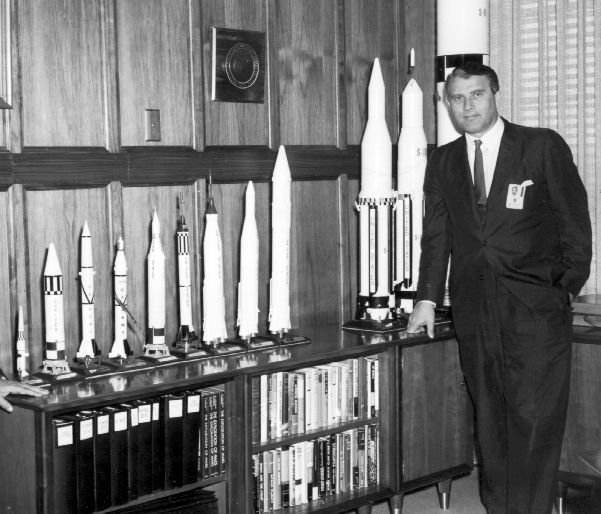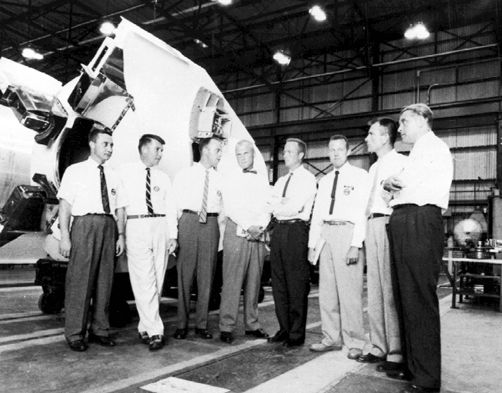Wernher von Braun, Rocket Pioneer: Biography & Quotes
Well-known as the leader of the American rocket team, which sought the launch astronauts into space, Wernher von Braun initially designed rockets for his native country of Germany during World War II. What led him to the United States, and why was he able to provide the boost necessary for sending men to the moon?
Early life
Wernher von Braun was born in Wirsitz, Germany, on March 23, 1912. The son of a Prussian baron, von Braun was the second of three sons of an aristocratic family. Young von Braun took an interest in the science fiction of Jules Verne and H.G. Wells, but it wasn't until he read the writings of the father of German rocketry, Hermann Oberth, that he applied himself to physics and mathematics, subjects he had previously struggled with in school.
He enrolled at the Berlin Institute of Technology, where he would go on to earn a bachelor's degree in aeronautical engineering. As a student, he joined the German Society for Space Travel, and worked with Oberth on liquid-fueled rocket tests. Von Braun went on to attend the University of Berlin, where he attained his doctorate in physics in 1934.
By that time, his group had successfully launched two rockets that reached heights of over 1.5 miles (2.4 kilometers). When the German government forbade rocket tests, the only way for von Braun to continue working with rockets was through the military.
A military career
In the late 1930s, von Braun began working as the technical director at the rocket research station at Peenemunde, in northeastern Germany. Studying the rocket designs of the American father of rocketry, Robert Goddard, von Braun's team developed the V-2 rocket.
Breaking space news, the latest updates on rocket launches, skywatching events and more!
He later recalled for a NASA history report that "[Goddard's] rockets ... may have been rather crude by present-day standards, but they blazed the trail and incorporated many features used in our most modern rockets and space vehicles."
Able to reach speeds of more than 3,500 mph (5,633 kph), the 46-foot, 27,000-pound (14 meters, 12,250 kilograms) V-2 rocket could carry warheads 500 miles (805 km). First used in September 1944, more than 5,000 were aimed at Britain. Of these, only 1,100 arrived on target, but they killed almost 3,000 people and injured thousands more. D-Day allowed the Allies to capture the launch sites of the rockets, ending the bombardment.
In 1944, von Braun was arrested by his government on charges of delaying or sabotaging the weapons program. He was eventually released after convincing them that he had been putting his efforts into the further development of rockets as weapons.
At the close of WWII, von Braun and his rocket team, including his brother, surrendered to the U.S. Army.
Von Braun's involvement with the Nazi party, and the atrocities that occurred in Germany, are still being debated. After his surrender, he issued several statements that his role in the National Socialist Party was undertaken only because to refuse would have ended his career.
Similarly, rocket-building facilities in Germany utilized concentration camp prisoners to assemble the weapons. Statements by von Braun indicate that he knew about the horrible conditions but felt any attempts to improve them would be futile, possibly putting himself in danger.
Changing sides
After coming to the United States, von Braun worked with the Army on the development of ballistic missiles. He became the technical director of the Army's Ballistic Missile Agency in Alabama in 1952, where he aided in the production and launching of the Redstone, Juno, Jupiter-C, and Pershing rockets. The Redstone rocket eventually carried Alan Shepard and Gus Grissom into space for the first and second American suborbital flights.
In 1947, von Braun returned to Germany to marry Maria Luise von Quistorp, and to bring her and his parents back to America. The couple had three children. In 1955, von Braun became a U.S. citizen.
After the 1957 launch of the Russian satellite Sputnik, the first manmade object to enter space, von Braun and his team assembled and launched the first American satellite, Explorer 1, on Jan. 31, 1958.
In 1960, von Braun and his team left the employ of the Army to join the newly formed National Aeronautics and Space Administration (NASA). Serving as director of NASA's Marshall Space Flight Center in Alabama, von Braun oversaw the development of the Saturn I, IB, and V. The Saturn V rocket lifted all of the Apollo lunar missions into space.
Von Braun served as NASA's deputy associate administrator for planning from 1970 until he resigned in 1972. He served as vice president of the aerospace company, Fairchild Industries, and founded the National Space Institute, a private industry seeking to gain support and understanding of space industries.
Von Braun died on June 16, 1977, at the age of 65.
Wernher von Braun quotes
"We can lick gravity, but sometimes the paperwork is overwhelming." — Chicago Sun Times, July 10, 1958
"There is just one thing I can promise you about the outer-space program: your tax dollar will go farther." — Reader's Digest, 1961
"I am convinced that before the year 2000 is over, the first child will have been born on the moon." — Taped TV Interview, broadcast on WMAL Washington, Jan. 7, 1972
"Research is what I'm doing when I don't know what I'm doing."
"I have learned to use the word 'impossible' with the greatest caution."
— Nola Taylor Redd, SPACE.com Contributor
Related:
- Wernher von Braun at 100: Moon Rocket Pioneer's Legacy Recalled
- Space History Photo: Dr. Wernher von Braun and Astronaut Cooper
- Space History Photo: Seamans, von Braun and President Kennedy at Cape Canaveral
- Space History Photo: Walt Disney and Wernher von Braun
Other Rocket Pioneers:
- Robert Goddard: American Father of Rocketry
- Konstantin Tsiolkovsky: Russian Father of Rocketry
- Hermann Oberth: German Father of Rocketry
- Saturn V Rockets & Apollo Spacecraft
Further reading:
- Wernher von Braun collection at NASA Marshall Space Flight Center History Office

Nola Taylor Tillman is a contributing writer for Space.com. She loves all things space and astronomy-related, and always wants to learn more. She has a Bachelor's degree in English and Astrophysics from Agnes Scott College and served as an intern at Sky & Telescope magazine. She loves to speak to groups on astronomy-related subjects. She lives with her husband in Atlanta, Georgia. Follow her on Bluesky at @astrowriter.social.bluesky


